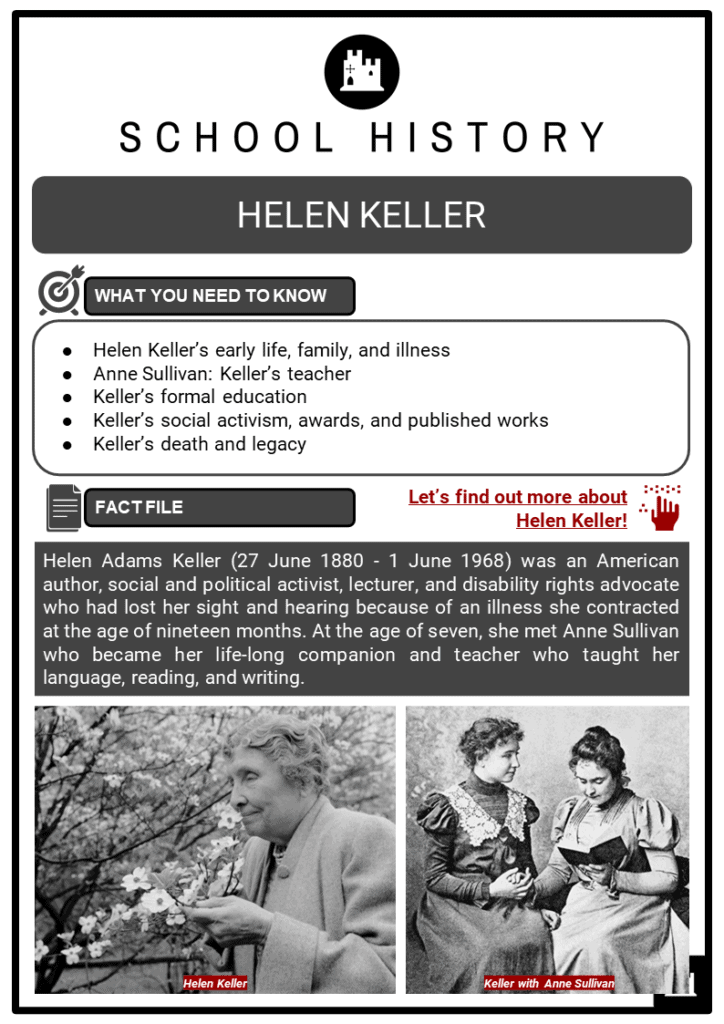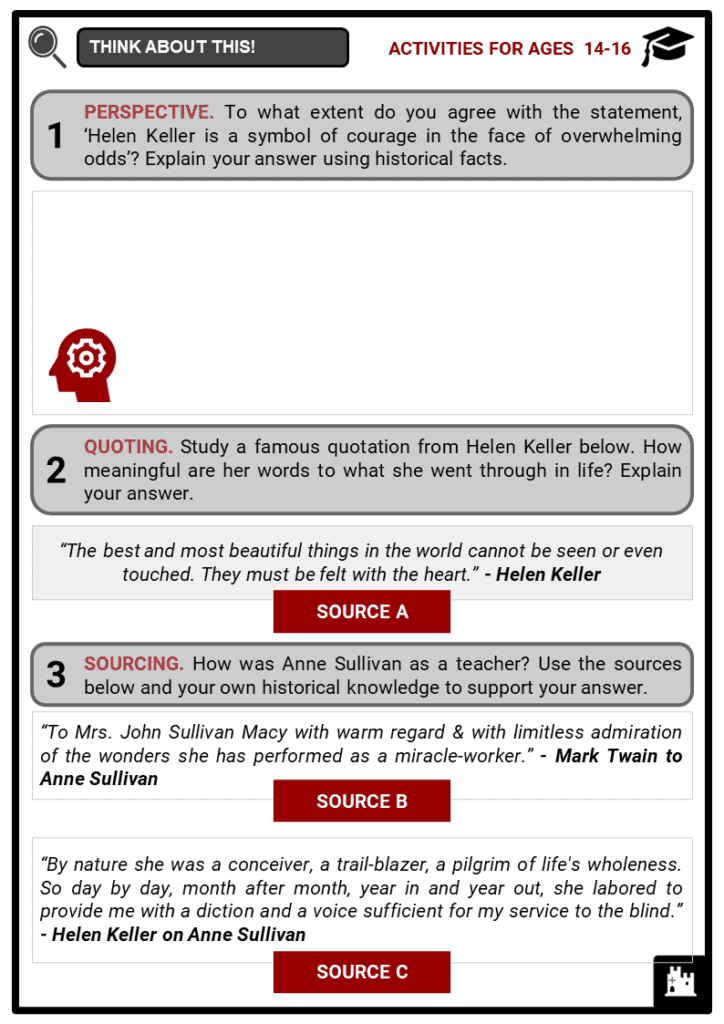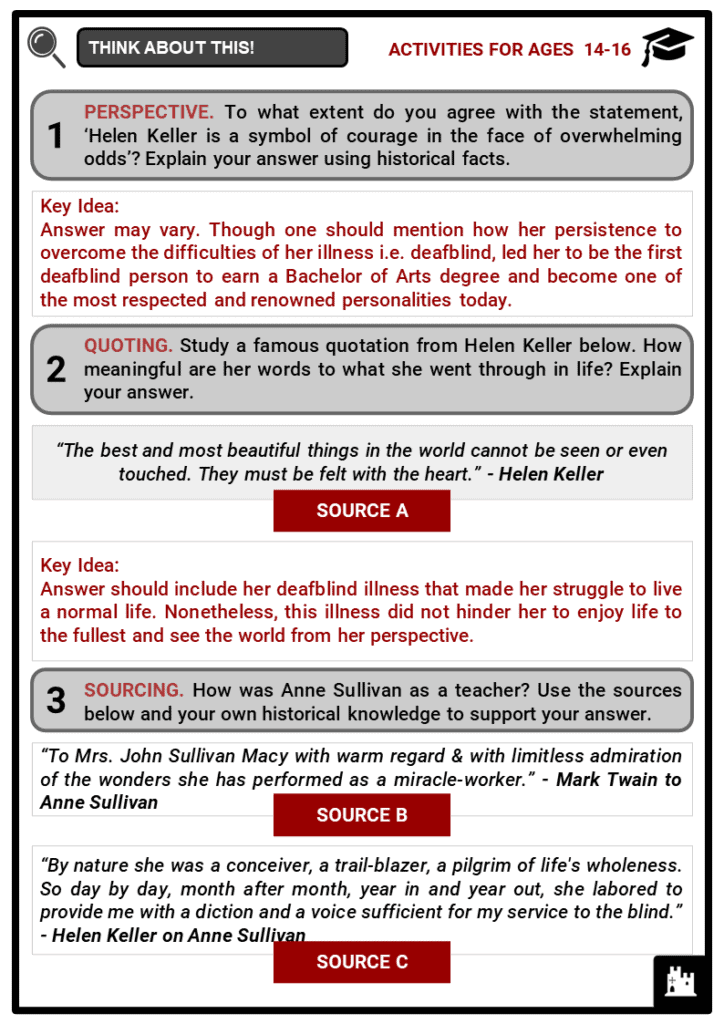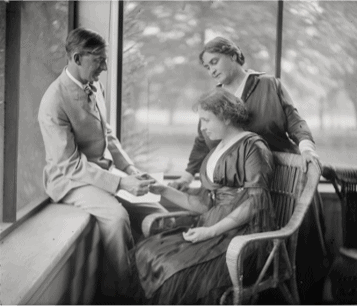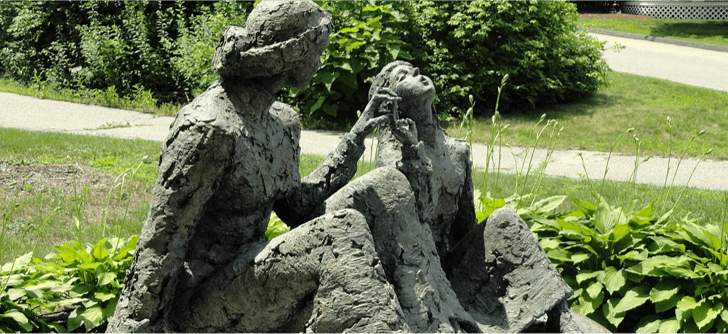Download Helen Keller Worksheets
Do you want to save dozens of hours in time? Get your evenings and weekends back? Be able to teach Helen Keller to your students?
Our worksheet bundle includes a fact file and printable worksheets and student activities. Perfect for both the classroom and homeschooling!
Table of Contents
Add a header to begin generating the table of contents
Summary
- Helen Keller’s early life, family, and illness
- Anne Sullivan: Keller’s teacher
- Keller’s formal education
- Keller’s social activism, awards, and published works
- Keller’s death and legacy
Key Facts And Information
Let’s find out more about Helen Keller!
- Helen Adams Keller (27 June 1880 - 1 June 1968) was an American author, social and political activist, lecturer, and disability rights advocate who had lost her sight and hearing because of an illness she contracted at the age of nineteen months. At the age of seven, she met Anne Sullivan who became her life-long companion and teacher who taught her language, reading, and writing.
- She was able to get a formal education at different schools and was able to graduate at the Radcliffe College of Harvard University, making her the first deafblind person to earn a Bachelor of Arts degree. After her graduation, she became a social activist and lecturer, tackling issues such as women’s suffrage, socialism, pacifism, and birth control. She received numerous accolades throughout her life and published a number of books and articles as well.
- She lived a remarkable life and was known as “a symbol of courage in the face of overwhelming odds” (Helen Keller Int 2021). Despite her illness, she was able to complete her education and triumph in social activism through her speeches and advocacies. Her persistence to overcome her difficulties made her become the respected and renowned person she is until this day.
Early Life and Family
- Helen Adams Keller was born in Tuscumbia, Alabama on 27 June 1880. She was the daughter of Catherine Everett “Kate” Adams Keller and Arthur Henley Keller, a Confederate Army officer during the Civil War and later the editor of a weekly local newspaper, the North Alabamian. She had two siblings by blood (Mildred Campbell Tyson, and Phillip Brooks Keller) and another two older half-brothers from her father’s prior marriage (James McDonald and William Simpson Keller).
- Helen’s family was not particularly wealthy, though they were part of the slaveholding elite before the Civil War. They earned income through their cotton plantation. They lived on a homestead which was built by Helen’s grandfather decades earlier.
Illness
- Helen Keller started speaking when she was just 6 months old and started walking at the age of 1. Although she was born with her senses of sight and hearing, she lost both of them at just 19 months old.
- In 1882, she contracted “brain fever” that produced a high body temperature. Though some speculate that her illness has been caused by scarlet fever or meningitis, the true nature of her “brain fever” is still unknown today. After the fever broke, Keller’s mother noticed that she made no reaction when a hand was waved in front of her, or when the dinner bell rang.
- As Keller grew, she and Martha Washington, the daughter of her family’s cook, created their own type of sign language. They invented more of it until they had about 60 signs to communicate with each other. However, as she grew older, she became wild and unruly, leading to many of her relatives feeling she should be institutionalised.
Helen Keller’s Teacher, Anne Sullivan
- In 1886, Helen Keller (accompanied by her father and instructed by her mother) sought out advice from an eye, ear, nose, and throat specialist in Baltimore, J. Julian Chisolm. The physician referred them to Alexander Graham Bell who then directed them to contact the Perkins Institute for the Blind, then located in South Boston.
- The school’s director, Michael Anagnos, asked an alumna of the school who was visually impaired herself, Anne Sullivan, to become Keller’s instructor. This started what would be a 49-year long relationship between the two.
- Sullivan arrived at Keller’s house on 5 March 1887. She began to teach her to communicate using spelling words into her hand. They began with the word d-o-l-l as Sullivan had brought Keller a doll as a present. Keller became frustrated at first because she could not quite understand why every object has a unique word to identify it.
- “I did not know that I was spelling a word or even that words existed. I was simply making my fingers go in monkey-like imitation.”
- “I stood still, my whole attention fixed upon the motions of her fingers. Suddenly I felt a misty consciousness as of something forgotten — a thrill of returning thought; and somehow the mystery of language was revealed to me. I knew then that w-a-t-e-r meant the wonderful cool something that was flowing over my hand. The living word awakened my soul, gave it light, hope, set it free!”
- The next month, a breakthrough in Keller’s communication came when she realised that w-a-t-e-r symbolised the cool running water Sullivan was flowing over her hand through a water pump.
- As time passed, Keller became very in touch with the outside world. She was able to create a connection with animals through touch and enjoy music by feeling the beats. Though there was a delay in her language skills, it didn’t stop her from having a voice. Sullivan also introduced her to Phillips Brooks from whom she learned Christianity.
- "I always knew He was there, but I didn't know His name!"
- Sullivan continued to be Keller’s teacher even when Sullivan married Harvard instructor John Macy in 1905. Keller even went to live with the two where they gave her their undivided attention. However, the couple gradually became distant to each other as Sullivan became too focused with Keller. The couple eventually separated, though never divorced.
Education
- 1888 - Helen Keller attended the Perkins Institute for the Blind.
- 1890 - She began speech classes in Boston at the Horace Mann School for the Deaf. For years, she learned to speak in a way that others would understand her.
- 1896 - She (still with Sullivan) went back to Massachusetts to enter The Cambridge School for Young Ladies.
- 1900 - She went to live in Briggs Hall, South House to study in Radcliffe College of Harvard University. Her education was sponsored by Standard Oil magnate Henry Huttleston Rogers whom her admirer, Mark Twain, had introduced to her.
- 1904 - At Radcliffe, she graduated and became the first deaf-blind person to earn a Bachelor of Arts degree.
- Keller was determined to communicate conventionally as possible so she spent most of her life giving speeches and lectures. Using the Tadoma method, she learned to “hear” others. Moreover, she also became proficient in using the braille.
Social Activism
- During the first half of the 20th century, Helen Keller began to be socially and politically active. She tackled issues such as women’s suffrage, socialism, pacifism, and birth control.
- When she graduated from college, news of her story spread and she soon became a well-known lecturer as she worked on behalf of others with disabilities. She strongly advocated for the improvement of the welfare of blind people.
- She co-founded, along with George Kessler, the Helen Keller International in 1915 and helped found the American Civil Liberties Union in 1920.
- In part of her friendship with John Macy, she became a member of the Socialist Party, writing several articles and essays about socialism between 1909 and 1921. As she expressed her socialist views, however, she gained public prejudice on her disabilities.
- In 1924, she became a member of the American Federation for the Blind and participated in campaigns to raise money and support for the blind.
- In 1946, she was appointed counselor of international relations for the American Foundation of Overseas Blind and travelled across five continents. At the age of 75, she went on the longest trip of her life, trekking 40,000 miles across Asia for five months. Her speeches and appearances throughout her life made her an inspiration to millions of people.
Awards
- 1936 - Awarded the Theodore Roosevelt Distinguished Services
- 1964 - Awarded the Medal of Freedom
- 1973 - Inducted into the National Women's Hall of Fame
- 1980 - Depicted in a stamp (together with Anne Sullivan) by the United States Postal Service
- 1999 - Listed in Gallup’s Most Widely Admired People of the 20th century
- 2003 - Featured in the Alabama state quarter, the only circulating US coin to feature braille
- 2009 - A bronze statue in honor of her was added to the National Statuary Hall Collection
Writings
- Helen Keller published The Frost King in 1891 while she was still 11 years old. However, there were allegations saying that this story was plagiarised from Margaret Canby’s The Frost Fairies. Investigations say that Keller might have experienced cryptomnesia while writing this work.
- In 1903, at the age of 22 and with the help of the Sullivan couple, she published her autobiography The Story of My Life which recounted her life story until age 21.
- In 1908, Keller’s The World I Live In was published. It shed light into her feelings about the world. Her series of essays centered on socialism, on the other hand, were released in 1913. This sparked a number of people to critique her socialist views.
- She released a spiritual autobiography titled My Religion in 1927. Here, she advocated Christian theologian Emanuel Swedenborg. In 1994, the title was revised and reissued under the title Light in My Darkness.
- Throughout her life, Keller wrote and published a total of 14 books as well as several essays, speeches, and articles.
Death and Legacy
- Helen Keller, in 1961, suffered a series of strokes and spent her remaining years in Connecticut. On 1 June 1968, she died at home in her sleep just a few weeks short of her eighty-eighth birthday.
- In her honor, a service was held for her at the National Cathedral in Washington, D.C. where her cremated ashes were placed next to her constant companion, Anne Sullivan.
- Keller lived a remarkable life and became a prime example of how an individual’s hard work and determination can lead to his/her triumph over adversity. Though she had an illness that could have prevented her from achieving what others can, her persistence to overcome her difficulties made her become the respected and renowned person she is until this day.
Image sources:
- https://upload.wikimedia.org/wikipedia/commons/thumb/f/f7/Helen_KellerA.jpg/1200px-Helen_KellerA.jpg
- https://japantoday-asset.scdn3.secure.raxcdn.com/img/store/06/e4/42989f0b32cb3dca60d7bd9cf93ba5c3f9ab/Portrait_of_Helen_Keller_with_Annie_Sullivan_Macy_and_John_Macy,_ca._1909-1919/_w850.jpg
- https://upload.wikimedia.org/wikipedia/commons/thumb/4/47/Anne_Sullivan_-_Helen_Keller_memorial_-_Tewksbury%2C_Massachusetts_-_DSC00072.JPG/1280px-Anne_Sullivan_-_Helen_Keller_memorial_-_Tewksbury%2C_Massachusetts_-_DSC00072.JPG

